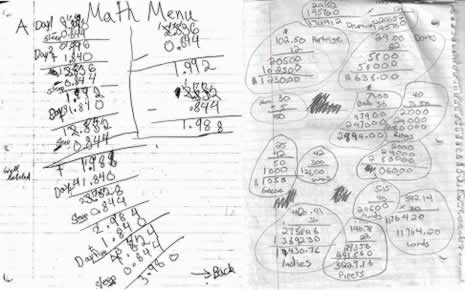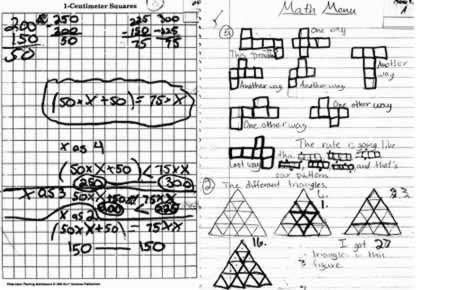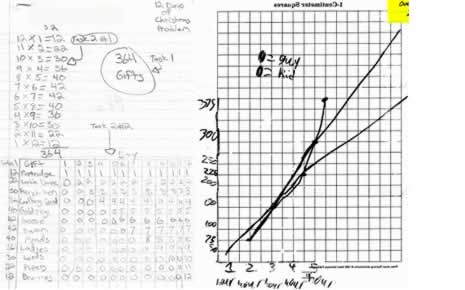What is
the Rule of 3? A Provisional Definition for Day-to Day Use
Timothy Boerst
It is important to get a sense of the day-to-day meanings of representations in the Rule of 3, so that they can be purposefully incorporated into/connected within instruction, consciously observed as students interact/create mathematical products, and fairly/openly assessed. The algebraic, numerical, and graphic representations that comprise the Rule of 3 may seem like fairly distinct entities that could be easily understood by teachers. Indeed, my TRG peers, with whom I interacted a great deal concerning the Rule of 3, never seemed confused or in doubt about what I was referring to when I talked about the representations. Perhaps one seemed to involve letters, another numbers, and the last diagrams. However in the course of writing about my research it has proven difficult to pin down the particular/unique meaning of each representation within the Rule of 3. This is perhaps due to the interconnected nature of mathematical representations (NCTM, 2000; Golden, 2001). For instance stem and leaf plots display specific numbers in graphic form and equations often combine specific numbers and algebraic variables.
With these qualifications in mind, I share here a sort of baseline for the focus and components of each representation, knowing that each is certainly more nuanced and interconnected with other representations than expressed here. I have also included linguistic representation since it is a tool used by students and teachers to understand and explain the use of Rule of 3 representations.
Representation focuses on specific values within algorithms, equations, lists, tables and the like.

Representation focuses on verbal and symbolic notation (such as variables) to generalize, formalize, model and extend..

Representation focuses on spatial, pictorial, geometric, visual displays.

Oral and written language used to understand, describe, analyze, explain, or reflect upon numerical, algebraic, or graphic representations.

Class Transcript
“The reason that I have asked you to measure the sides of these triangles is to let you know that numbers can also help us to think more deeply about shapes. So what I would like for use to do is, I will just make a chart on the board. Tell me the lengths of the sides on your triangles and I want to see if we can find a pattern in these numbers and we will have a bunch up here until we can see a pattern…” (many examples are shared)
“Lets look at this example, 11,5, 1. Why can’t this be a triangle?”
“I don’t know if this is right, but it has to slant in to make a triangle”
“Can anybody build on that or keep going?”
“This is why I think. I think its because one of those has to be longer in order for all of them to connect.”
“What do you mean?”
“Like the medium sized one if you put it on the corner it can’t connect with the little one, even it is was on one side it couldn’t connect.”
“Can anyone go from there?”
“The two smaller ones have to either like add up, like 5 and 1 don’t come close to 11 they are only 6”
“That is what I was trying to say.”
“The number can never leave it open or else that won’t be the shape, a polygon.”
“um This might belong with something else, but every triangle has to have a half in order make a real triangle.”
“That is interesting. All of these have halves. I don‘t know if that has to be the case, but that is the case so far. Let’s finish off this one but that is a great start that we could explore later if we wanted to.”
“They have to all be in the same like type of number range in order to connect.”
“So that is kind of like what Michelle was saying a little while ago. Like if the numbers are too far apart they won’t connect.”
“Yeah.”
“How could we write an equation that shows this relationship?”
All Rule of 3 representations can be used individually or in concert to solve mathematical problems, support exploration, and share the results of mathematical work. In other words they can support the plausible reasoning necessary to work through a problem (a means of solving a problem) and also the demonstrative reasoning necessary to clearly communicate and prove the validity of one’s solution (the ends of problem solving activity) (Polya, 1954).
Links to electronic sources with more information about the Rule of 3
- An illustration of Rule of 3 work to explore the advanced mathematics of boat hulls (note the progression of numerical, graphic, and algebraic representations)
- Information on the Rule of 3 from the first calculus reform newsletter (pdf)
- An overview of the features of a reform calculus text (pdf) (note the switch in wording of the Rule of 3)
- A detailed explanation from Villanova of the interconnections of the Rule of 3 element (notice the title reads rule of 4; for further explanation see the first footnote below)
1. Originally the Rule of 3 was delineated in reformed calculus materials as encompassing geometric, numerical, and algebraic representations (Hughes-Hallett et al, 1994). However subsequent editions of these texts and interpretations of the Rule of 3 by others in the field have made it clear that attention would not be as much upon geometric representations (at least not as most teachers would interpret that title) as upon graphical/spatial representations of mathematical topics. In fact most current references to the Rule of 3 replace “geometrically” with “graphically”. Furthermore, Hughes-Hallett and others have amended the Rule of 3 to include verbal representation as well. For these reasons I chose, early in my TRG work, to define the Rule of 3 as comprised of numerical, algebraic, and graphic representations. I also have attended closely to verbal representations as I have conducted my research, but did not want to change terminology to the “Rule of 4” to avoid confusion among TRG members (and myself for that matter).
2. Elsewhere in this snapshot I discuss the importance and utility of interconnected representations.